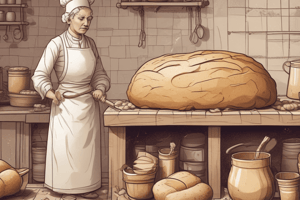Podcast
Questions and Answers
What is the optimal temperature range for activating yeast?
What is the optimal temperature range for activating yeast?
- 100°F to 110°F (correct)
- 120°F to 130°F
- 90°F to 100°F
- 70°F to 80°F
What happens if water for yeast activation is too hot?
What happens if water for yeast activation is too hot?
- Yeast will become more potent
- Yeast will not activate (correct)
- Yeast will activate faster
- Yeast will activate but with a different flavor
What gives dough its structure and elasticity?
What gives dough its structure and elasticity?
- Fats
- Gluten (correct)
- Carbohydrates
- Sugars
What is released when yeast consumes carbohydrates during fermentation?
What is released when yeast consumes carbohydrates during fermentation?
What is the purpose of punching or folding the dough during fermentation?
What is the purpose of punching or folding the dough during fermentation?
What is the purpose of docking the surface of the risen dough?
What is the purpose of docking the surface of the risen dough?
What is the importance of kneading the dough in making yeast bread?
What is the importance of kneading the dough in making yeast bread?
What is docking in bread making and why is it done?
What is docking in bread making and why is it done?
What are some common problems encountered in baking bread and their probable causes?
What are some common problems encountered in baking bread and their probable causes?
Match the yeast activation temperature with the corresponding outcome:
Match the yeast activation temperature with the corresponding outcome:
Flashcards are hidden until you start studying




